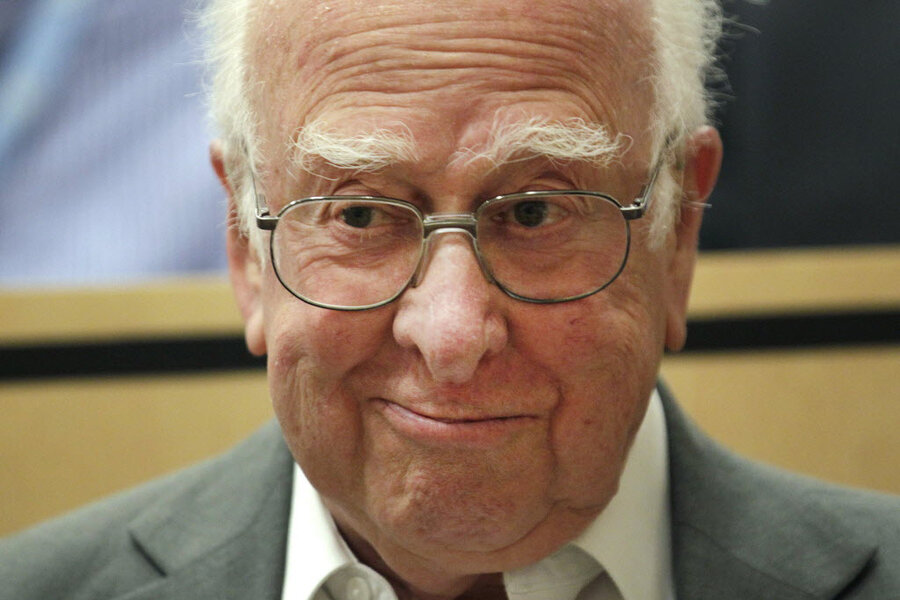Higgs boson work leads to one Nobel Prize. Could there be another?
Loading...
The 2013 Nobel Prize in Physics has been awarded to two physicists, Francois Englert and Peter Higgs, who independently proposed the mechanism that gives subatomic particles their mass.
Without this mechanism, physicists say, subatomic particles would ping around the universe at the speed of light without interacting and forming atoms and molecules, the building-blocks of matter.
In announcing the award on Tuesday, the Royal Swedish Academy of Sciences cited Drs. Englert and Higgs for their work on what has become known as the Brout-Englert-Higgs field and its related particle, the Higgs boson.
In 1964, Englert and his colleague, the late Robert Brout, proposed that space was permeated by a field that imparted mass to particles moving through it. A particle's mass depended on how strongly it interacted with this field – the stronger the interaction, the more massive the particle.
Higgs offered a similar explanation and predicted that the field would have a particle associated with it. The particle became known as the Higgs boson. The prediction triggered a nearly 50-year quest among experimental physicists to find the particle.
Find it they did. On July 4, 2012, two international teams of physicists at the European Organization for Nuclear Research announced that they had discovered the particle at the facility's Large Hadron Collider (LHC). Last March, the teams announced a higher level of confidence in their detection based on additional data their cathedral-scale detectors at the collider had amassed in the interim.
Sifting through the debris of some 2,000 trillion collisions at the accelerator – an underground race-track for protons accelerated to nearly the speed of light – researchers uncovered evidence for 1,500 Higgs bosons fleetingly created by the collisions.
"I am overwhelmed to receive this award and thank the Royal Academy," Higgs said in a prepared statement issued by the University of Edinburgh, where he is a professor emeritus.
In issuing the award, the Academy used a unique turn of phrase that suggested to some that the body might be open to issuing another prize at some point for the discovery of the Higgs boson.
The Academy noted that the prize was "for the theoretical discovery of a mechanism that contributes to our understanding of the origin of mass of subatomic particles," and went on to mention the work at CERN confirming Higgs's prediction.
"The term 'theoretical' has never been used before with discovery," observes Lawrence Sulak, a physicist at Boston University whose team contributed key instruments for one of the two massive detectors at the LHC, known as the CMS detector.
This could leave the door open for "a future prize for the actual experimental discovery," he wrote in an e-mail.
An additional award would be a challenge, others observe. Under the Nobel rules, an award can go to no more than three living people, while the collaborations for each of the two detectors consisted of roughly 3,000 researchers each.
With those kinds of numbers, "it becomes extremely difficult to point to three people," says Don Lincoln, a physicist at the Fermi National Accelerator Laboratory in Batavia, Ill., and another collaborator on CMS.
Still, he says he suspects that over the years, "the Swedish Academy of Sciences will recognize the fact science is getting big, so maybe they can apportion credit to groups," as the Nobel Peace Prize does.
Even if no similar recognition for experimentalists results from this stage of exploring the Higgs boson, the future is big with promise, researchers say.
Physicists say they have every indication so far that the particle discovered last year is the Higgs. "But we are not yet confident," Dr. Sulak cautions.
This means that even though a Nobel prize has been awarded for the theory describing the Higgs phenomenon, questions still swirl around the particle associated with the Higgs field.
Start with the particle's mass. No one knew what it would be. Theories presented a range of possibilities. The particle physicists detected has far less mass than some models predict and far more than others.
"It's too heavy to be light and too light to be heavy. It's in a mysterious place, and we don't understand why that is," says Tom LeCompte, a physicist at Agronne National Laboratory in Argonne, Ill., and the physics coordinator for the ATLAS experiment, the second of the two large detectors at the LHC.
For instance, the “standard model,” which describes subatomic particles and their interactions, predicts that the Higgs boson’s mass should be a quadrillion times higher than the particles detected at CERN, says Dr. Lincoln.
Still, with the discovery of the particle, "we have completed our understanding of the standard model," he continues. But there are mysteries that may point to something beyond it. It's still unclear where gravity fits into this model, for instance, as well as dark matter and dark energy. The discovery of dark energy, which is accelerating the expansion of the universe, garnered its discoverers their own Nobel Prize in Physics in 2011.
The discovery of the Higgs boson "gives us a little frayed thread sticking out of the quilt that we will, of course, tug at” hoping to unravel these mysteries, he says.
Higgs and Englert will split the prize's $1.2 million purse and are slated to receive the award at a ceremony in Stockholm Dec. 10.







